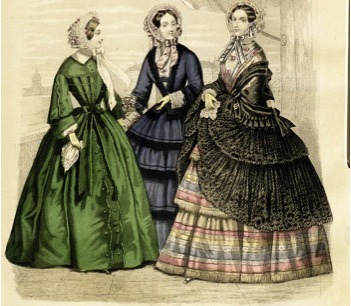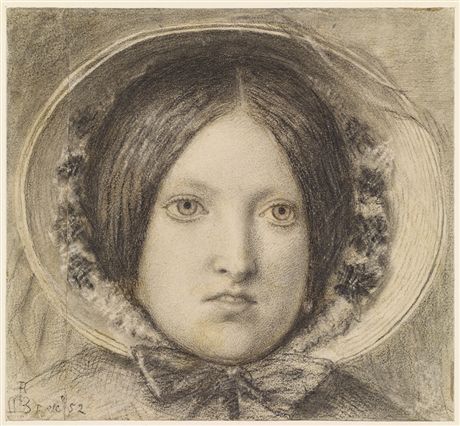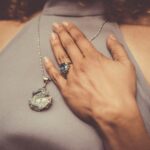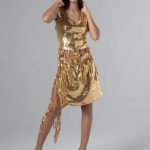Every season—spring, fall, summer, and winter—was awash in hats in the nineteenth century. There were hundreds of options! Popular clothing fashions and hairstyles heavily influenced women’s hat styles. Newspapers advised women to wear colors that complemented their clothing and complexions.
Men’s hats were symbolic of status and more functional, or they were part of a work uniform. There was, however, a wide range of toppers for young men. In the summer, both men and women wore straw hats, and in the winter, felt hats.
Here are some facts about 1800s women’s hats.
The Early 1800s
Women’s fashions at the turn of the century reflected simple, classic styles and an interest in a romanticized pastoral life. Rustic bonnets came in various styles and could be plain or embellished with artificial flowers. Straw bonnets with wide brims were popular in warm weather.
Popular designs included:
- Capote bonnets featuring gathered crowns with stiff brims. The brims grew to become Poke bonnets later on.
- The Poke bonnet with a small crown and a large, forward brim shielded the wearer’s face from the sun and rain. The Poke bonnet, or The Hat of the American West, was worn in urban and rural settings.
- The Calash was popular in the 18th century and was formed over collapsible cane hoops or whalebone.
- The “Gypsy” hat has a low crown and a moderately wide brim. Ribbons were tied under the chin and fastened around the outside of the bonnet.
Romantic Period Hats: 1820-1850

The Romantic Period placed a premium on sentimentality and emotion. The goal of the fashion elite was to appear lethargic and pale by wearing garments that restricted movement. For both urban and rural women, bonnets remained a popular headgear.
Enslaved people in the American South wore bonnets, turban-like head wraps, and mobcaps. Indoors, mature women continued wearing day caps.
They embellished hats with high, rounded crowns and wide brims with lace and large feathers. Birds of paradise blooms were in high demand between 1835 and 1845.
Bonnets were embellished with flaps, bavolets, or ruffles that hung down the back of the neck. Hats with attached veils that you could throw back over the crown of your head or hung forward across the front brim were popular among fashionable women.
A central dip emerged in the center point of the bonnet brim in the 1840s, forming a heart-shaped frame for the face. The front brim’s underside was embellished with lace, ruffles, or other trim.
They made drawn bonnets from wire or cane. The silk was sewn with small channels, and the fabric was pulled over the cane. The newer version, like the calash bonnet of earlier years, was rounder and smaller than the 1700s tall oval bonnet.
For the rest of the century, women who participated in equestrian sports wore top hats in men’s style. A loose veil was draped over her. Women wore large, round straw hats with down-turned brims and flat, low crowns for the garden, beach, or country.
Crinoline Period Hats: 1850-1869

The Crinoline Period was characterized by the expansion of women’s skirts, first with crinolines and then with the addition of hoops. While Paris stayed the fashion capital, Queen Victoria wielded considerable power and encouraged the expansion of industrial production. Older women wore day caps with lappets, which were long ribbons and extensions hanging at the sides from the front.
The bonnet was still in charge. Bonnet crowns were sloped backward and lower, with broad front brims. From the 1850s to the early 1860s, lappets were mounted from the front of bonnets.
Snoods, or beaded hair nets, were popular at the time. A loose net-like weave drooped from a headband, softly enveloping the hair rolled at the back of the head.
Small hats sat forward in the 1860s. Round crowns with narrow brims were typical of sailor hats. Women wore tilted-back bonnets with the front section of the crown built high with ornamental grass, decorative feathers, and artificial flowers or fruit at the time. Bavolets were frequently hung from the back.
Late Victorian Hats
The 1870s and 1800s were characterized by a materialistic culture prioritizing consumer consumption. Women’s clothing and hats reflected the extravagant sentiment, with massive bustles at the back of dresses and extravagant ornamentation. Conversely, at the end of the century, the Dress Reform Movements, Aesthetic Movement, and a renewed interest in sports resulted in a simplification of styles.
Women wore hats and bonnets tilted up or set forward to cater to large piles of hair on top and behind the head. Hat and bonnet crowns became popular as hairstyles became more simple.
- Brimless toques gained popularity.
- Garrison caps were jaunty and small, with feather decorations.
- The Post Boy hat, worn high on the head, had a narrow brim and a high crown.
- Boaters were identical to men’s versions. Boaters were straw hats with a medium brim, a flat crown, and a ribbon around the base of the crown.
- The Trilby resembled a Fedora hat. Trilby hats have a smaller brim that is turned up in the back and has less noticeable creasing. Men and women wore the style, with women’s styles starring more embellishment.
By the 1890s, they no longer wore day caps indoors; hat sizes ranged from small to medium, with some hats lacking brims. Hats had more decorations and trims, such as ribbons, flowers, lace, and feathers. The hat’s embellishments were pinned on one side and rose above the crown.
Feathers as Decoration in the Late 1800s and the Decline of Wild Bird Populations
Women’s hats were adorned with bird feathers and plumes for much of the century until the early 1900s. From 1875 to 1886, hats were adorned with entire wings or stuffed birds.
The feather trade was so massive that it decimated wild bird populations. During the breeding season, when the plumage was at its most attractive, birds were killed, leaving nestlings to die of starvation.
Conservatives spread rumors that feathers were collected from the ground at rookeries. Some even believed that wild birds were an endless source of food.
Harriet Hemenway and her cousin Mina Hall urged women’s groups to assist in the abolition of the slaughter of egrets, kittiwakes, birds of paradise, roseate spoonbills, flamingos, and great crested grebes. In 1897, they founded the Massachusetts Audubon Society with ornithologist William Brewster and launched a boycott that ultimately led to the state’s wild bird feather trading prohibition. Emily Williamson of Manchester pushed for the formation of England’s Society for the Protection of Birds.
By 1918, the Migratory Bird Treaty had put an end to the trade of many wild birds, preventing the extinction of the Sandhill Crane, Snowy Egret, and Wood Duck and assisting in population restoration.
The post What Hats Were Worn by Women in the 1800s? first appeared on thedailyvogue.com.








